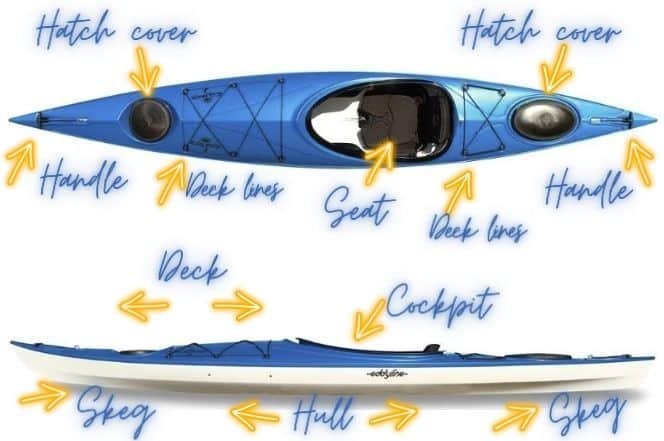In this article we wanted to answer some common questions about kayaks. We have been kayaking for decades and want to share our information, so welcome to check these kayak questions and their answers!
Are kayak seats universal?
Kayak seats are mostly not universal. Kayak seats are designed to fit specific models of kayaks. Therefore they may not be interchangeable between different brands and models. It is important to purchase a seat that is specifically designed for your kayak in order to ensure a proper fit and comfort. Additionally, some kayaks come with adjustable or customizable seats. It’s important to check the specifications of your kayak before purchasing a replacement seat. Read more about kayak seats here.
How are kayaks made?
Kayaks are made in different ways, depending on the material used. The most common materials are plastic, carbon- or glass fibre and wood.
Plastic kayaks are typically made in two different ways. One is through a process called rotational molding, also known as rotomolding. In rotomolding, a hollow mold is filled with a plastic material in a powdered or pellet form. The mold is then placed in an oven and rotated around two perpendicular axes, allowing the material to spread evenly and form a consistent wall thickness. The plastic is then heated to a high temperature, causing it to melt and flow into all areas of the mold. The other method used to make plastic kayaks is thermoforming, where sheets of plastic are heated up and shaped with vacuum- or mechanical pressure.
Composite materials such as fiberglass, carbon fiber, or Kevlar are used in more high-end touring kayaks. In this process, layers of the composite material are laid out over a mold and then cured using heat or resin. This can be done in a manufacturing facility or even in smaller workshops. My dad actually made a canoe for our family with fibreglass by taking part in a community class.
The most traditional method to build kayaks was by using wood. This wood was often covered by an animal skin to make it lighter and more waterproof.
What are the different parts of a kayak?
The main parts of a kayak are:
- Hull: The main body of the kayak that sits in the water and provides flotation.
- Deck: The top surface of the kayak that covers the interior of the kayk. The deck provides a platform for the paddler in sit-on-top kayaks.
- Cockpit: In sit-in kayaks the cockpit is the opening in the deck. The paddler sits in and paddles the kayak from.
- Seat: The place where the paddler sits in the cockpit or on top of the kayak. It is usually adjustable to provide comfort and support.
- Footrests: Pedals or footrests that the paddler can adjust to provide a comfortable and secure position while paddling and to give more power to the paddle strokes.
- Bulkheads: Partitions within the kayak that help provide stability and keep water out of the interior.
- Hatch covers: Removable covers over compartments within the kayak for storing gear and supplies.
- Rudder or skeg: A control device that helps the kayak maintain a straight course or makes it easier to turn. Some kayaks have a rudder that can be deployed and controlled by the paddler, while others have a fixed skeg.
- Paddle: A long, flat blade that is used to propel the kayak through the water.
- Deck lines and bungee cords: Lines and cords on the deck that are used to secure gear and provide additional storage space.
- Carrying handles: Handles on the hull or deck of the kayak that make it easier to carry and transport.

Are kayaks stable? Do kayaks flip easily?
The stability of a kayak can vary depending on the design, length, width, and rocker (the curvature of the hull from bow to stern). Generally, wider kayaks tend to be more stable than narrow ones. Also longer kayaks tend to be more stable than shorter ones. However, the stability of a kayak can also be affected by factors such as the weight distribution of the paddler and any gear they may be carrying, as well as the conditions of the water (such as wind, waves, and currents).
It is important for kayakers to understand their own limits and to be aware of the conditions they are paddling in. As well as to practice proper paddling techniques and safety measures.
Which Kayaks are made in the US?
There are many kayak brands and manufacturers that make kayaks in the USA. Some of the most well-known brands that manufacture kayaks domestically include:
- Dagger
- Perception
- Wilderness Systems
- Old Town Canoe and Kayak
- Jackson Kayak
- Native Watercraft
- Liquidlogic
It is important to note that not all kayaks made by these brands are manufactured in the USA. Some may have components or materials sourced from other countries. If you are looking for a kayak made entirely in the USA, it is best to check with the manufacturer or research the specific model you are interested in.
There are also small, local kayak builders and custom shops that handcraft kayaks in the USA, offering unique and custom options for those looking for a one-of-a-kind kayaking experience.
Who invented kayaking?
The origins of kayaking can be traced back thousands of years to the Inuit and Aleut peoples of the Arctic regions. They used their kayaks for hunting and fishing. These indigenous peoples crafted kayaks from animal skins stretched over a wooden frame. These lightweight vessels were used for transportation and survival on the water.
